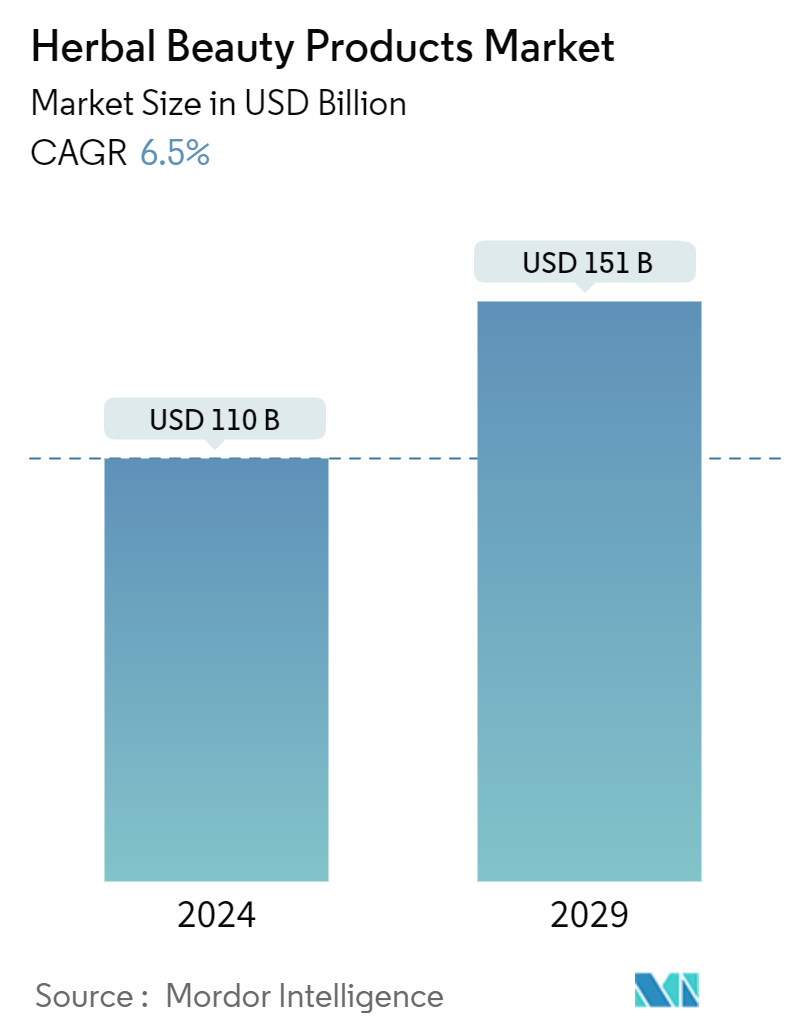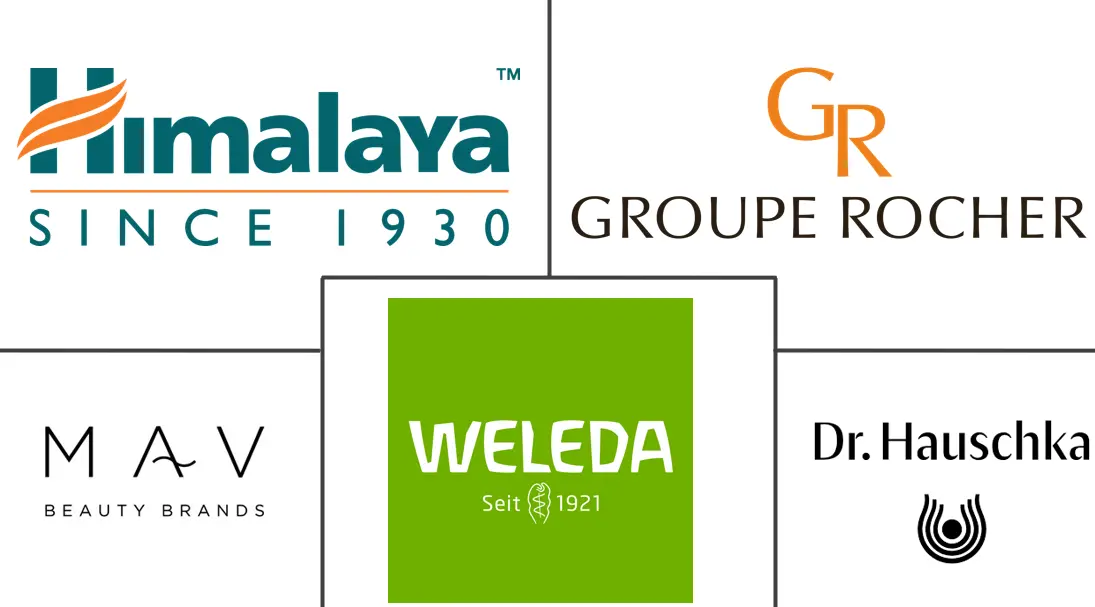Market Size of Herbal Beauty Products Industry

| Study Period | 2019 - 2029 |
| Market Size (2024) | USD 110 Billion |
| Market Size (2029) | USD 151 Billion |
| CAGR (2024 - 2029) | 6.50 % |
| Fastest Growing Market | Asia Pacific |
| Largest Market | North America |
| Market Concentration | Low |
Major Players
*Disclaimer: Major Players sorted in no particular order |
Herbal Beauty Products Market Analysis
The Herbal Beauty Products Market size is estimated at USD 110 billion in 2024, and is expected to reach USD 151 billion by 2029, growing at a CAGR of 6.5% during the forecast period (2024-2029).
The growing inclination toward enhancements in appearance and looks, combined with increased adoption of herbal products among consumers, is anticipated to benefit the expansion of the herbal beauty products market worldwide in the forecast period. The demand for herbal beauty products is increasing owing to rising consumer awareness regarding the harmful effects of the chemicals added to beauty products. Moreover, beauty companies have been acquiring herbal beauty and personal care brands to expand their consumer base, which is progressively passionate about clean, green, and herbal products.
The demand for herbal beauty products is anticipated to be driven by the rising usage of cosmetics containing organically derived herbal compounds like lavender, chamomile, rosemary, jojoba oil, and aloe vera to treat skin, acne, and hair issues. Since herbs frequently have strong antibacterial and antioxidant effects and provide pigmentation inhibition, herbal extracts are primarily incorporated into beauty products. Additionally, herbal ingredients that protect skin from UV rays and pollution include vitamins, witch hazel, willow herb, green tea extract, and botanical extracts. All of these factors are set to boost the demand for herbal beauty products.
Herbal Beauty Products Industry Segmentation
Herbal beauty products are beauty products made of natural herbal ingredients such as aloe vera, almond, avocado, carrot, castor, clay, cocoa, coconut oil, cornmeal, and cucumber, avoiding chemical usage. The herbal beauty products market is segmented by product type, distribution channel, and geography. Based on product type, the market is segmented into skin care products, hair care products, makeup and color cosmetics, fragrances, and other product types. Based on the distribution channel, the market is segmented into supermarkets/hypermarkets, convenience stores, specialty stores, online stores, and other distribution channels. Based on geography, the market is segmented into North America, Europe, Asia-Pacific, South America, and the Middle East and Africa. For each segment, the market sizing and forecasts have been done based on value (USD).
| Product Type | |
| Skin Care | |
| Hair Care | |
| Makeup and Color Cosmetics | |
| Fragrances | |
| Other Product Types |
| Distribution Channel | |
| Supermarkets/Hypermarkets | |
| Convenience Stores | |
| Specialty Stores | |
| Online Stores | |
| Other Distribution Channels |
| Geography | |||||||||
| |||||||||
| |||||||||
| |||||||||
| |||||||||
|
Herbal Beauty Products Market Size Summary
The herbal beauty products market is experiencing significant growth, driven by a rising consumer preference for products that are free from harmful chemicals and environmentally sustainable. This trend is fueled by increased awareness of the adverse effects of synthetic ingredients in beauty products, leading to a surge in demand for cosmetics containing naturally derived herbal compounds. The market is further bolstered by the acquisition of herbal brands by major beauty companies, expanding their consumer base among those who prioritize clean and green products. The incorporation of herbal extracts known for their antibacterial, antioxidant, and UV protection properties into beauty products is also contributing to market expansion. The influence of social media and beauty blogs, which highlight the benefits of herbal products and advocate against animal testing, is playing a crucial role in shaping consumer preferences and driving sales.
Regionally, the Asia-Pacific market is witnessing robust growth due to increased consumer awareness, willingness to invest in quality herbal products, and a shift towards healthier, low-impact lifestyles. The popularity of traditional Chinese ingredients and vegan lifestyles among millennials is further propelling market growth. Key players in the market are focusing on sustainability by forming partnerships and emphasizing the quality and origin of their raw materials. The market is characterized by a fragmented landscape with numerous competitors, including prominent companies like Arbonne International LLC, Weleda AG, and Himalaya Herbals, who are engaging in strategies such as mergers, acquisitions, and new product development to meet the growing demand. The introduction of products with exotic ingredients, such as snail cream facial masks and organic serums, is also gaining traction, reflecting the increasing consumer preference for natural and effective beauty solutions.
Herbal Beauty Products Market Size - Table of Contents
-
1. MARKET DYNAMICS
-
1.1 Market Drivers
-
1.1.1 Increased Preference of Consumers Toward Natural and Skincare Solutions Driving Market Growth
-
1.1.2 Influence of Social Media and Celebrity Endorsements Positively Impacting the Market
-
-
1.2 Market Restraints
-
1.2.1 Restricted Availability and Supply Chain Difficulties Hampering Market Growth
-
-
1.3 Porter's Five Forces Analysis
-
1.3.1 Threat of New Entrants
-
1.3.2 Bargaining Power of Buyers/Consumers
-
1.3.3 Bargaining Power of Suppliers
-
1.3.4 Threat of Substitute Products
-
1.3.5 Intensity of Competitive Rivalry
-
-
-
2. MARKET SEGMENTATION
-
2.1 Product Type
-
2.1.1 Skin Care
-
2.1.2 Hair Care
-
2.1.3 Makeup and Color Cosmetics
-
2.1.4 Fragrances
-
2.1.5 Other Product Types
-
-
2.2 Distribution Channel
-
2.2.1 Supermarkets/Hypermarkets
-
2.2.2 Convenience Stores
-
2.2.3 Specialty Stores
-
2.2.4 Online Stores
-
2.2.5 Other Distribution Channels
-
-
2.3 Geography
-
2.3.1 North America
-
2.3.1.1 United States
-
2.3.1.2 Canada
-
2.3.1.3 Mexico
-
2.3.1.4 Rest of North America
-
-
2.3.2 Europe
-
2.3.2.1 Spain
-
2.3.2.2 United Kingdom
-
2.3.2.3 Germany
-
2.3.2.4 France
-
2.3.2.5 Italy
-
2.3.2.6 Russia
-
2.3.2.7 Rest of Europe
-
-
2.3.3 Asia-Pacific
-
2.3.3.1 China
-
2.3.3.2 Japan
-
2.3.3.3 India
-
2.3.3.4 Australia
-
2.3.3.5 Rest of Asia-Pacific
-
-
2.3.4 South America
-
2.3.4.1 Brazil
-
2.3.4.2 Argentina
-
2.3.4.3 Rest of South America
-
-
2.3.5 Middle East and Africa
-
2.3.5.1 United Arab Emirates
-
2.3.5.2 South Africa
-
2.3.5.3 Rest of Middle East and Africa
-
-
-
Herbal Beauty Products Market Size FAQs
How big is the Herbal Beauty Products Market?
The Herbal Beauty Products Market size is expected to reach USD 110 billion in 2024 and grow at a CAGR of 6.5% to reach USD 151 billion by 2029.
What is the current Herbal Beauty Products Market size?
In 2024, the Herbal Beauty Products Market size is expected to reach USD 110 billion.

